This week two different people asked me pretty much the same question. That usually tells me that something “everyone knows” is actually not something everyone knows!
The questions were about replacing strings. Not how to replace them, but tips and tricks for replacing them more easily. Broken strings are a fact of life for harpers. And needing to change out dead or “thuddy” strings is also something every harper has experienced (or will) – necessitating changing strings or completely restringing the harp.
Like any activity that is essential if not fun, it helps to be prepared. I have restrung my harp (that could be a whole other post!), but I am mostly prepared for having to replace a broken string at a performance. I have a handy-dandy kit just for that! I made it for my harp case pocket, but when I’m home in my studio, I have it on the shelf. I’m pleased with my set-up and I think from the reactions I’ve gotten from other people at workshops, competitions, and schools, many others think my set-up is pretty cool.
So, this week I’m going to share it with you. As with so many things, this is my way. It is, by no means, the only way or even necessarily the best way. But it has worked for me for a long time. It also makes me smile when i see it. Silly, yes, but so what?! This set up not only keeps all the things I need close to hand, it also keeps everything organized, clean, and unbroken. Is everything you might ever need for a broken string at a gig in there? No, but there’s enough to get out of trouble.
This all started because I would toss my tuner into my harp case pocket and then worry that it would turn on and run the battery down, or get broken, or just come apart. So I started looking for a way to protect it. Then I realized that I also wanted to carry the pickup which is also somewhat delicate. That’s where the box came in. But that was a lot of room, so the other stuff slowly joined in!
Note that these are all items from my set up – this is not an endorsement of any product or brand. Use what you have and stock your kit with what you like.
Let’s get started on our tour.
First, the outside. I use a sandwich box. There’s nothing special about it. It’s just inexpensive – grocery store bought sandwich box. I like it because it fits everything I want to have without taking up a lot of volume in the pocket. What’s really important is that the lid fits and stays closed and that it has enough room for what you want to carry. This assures that the tuner ON button doesn’t get accidentally pushed which is really my biggest concern!
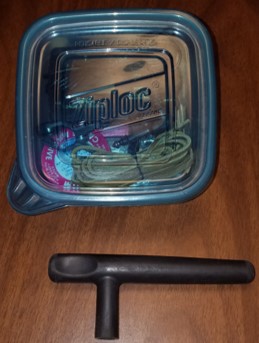 Next, let’s take a look inside! Under the lid, you can see that it takes a little bit of finagling and tessellation to get everything in – but it works! I do capitalize on the flexibility of some of the items to overcome the limitations of the inflexibility of the others.
Next, let’s take a look inside! Under the lid, you can see that it takes a little bit of finagling and tessellation to get everything in – but it works! I do capitalize on the flexibility of some of the items to overcome the limitations of the inflexibility of the others.
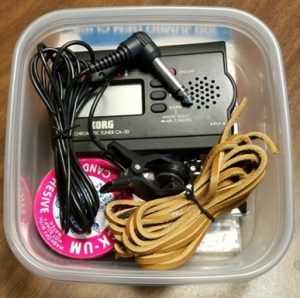 So, let’s unpack so you can see what’s in there. Remember too that this is a gig bag item, so it has to serve both tuning and string replacement.
So, let’s unpack so you can see what’s in there. Remember too that this is a gig bag item, so it has to serve both tuning and string replacement.
First I have a pickup. I know this is likely not strictly necessary, but my sound board is beautiful and responds to just about everything. I think using a pickup helps me tune faster and better – so I use it. I keep it in the box because it is somewhat delicate and the wires can be broken and I don’t want to have to be buying another one every time I turn around!
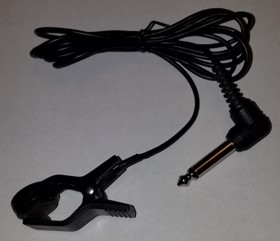 Next is the tuner itself. In all honesty, I have another tuner but this is my favorite…and you can see that it’s small and flat and fits into the box really well (I keep the other tuner in a different box – mostly because although I like it but it wouldn’t fit in this box!). Additional bonus? Not having to fish around in the case pocket trying to find this tuner – the sandwich box is big enough to easily grab from the pocket.
Next is the tuner itself. In all honesty, I have another tuner but this is my favorite…and you can see that it’s small and flat and fits into the box really well (I keep the other tuner in a different box – mostly because although I like it but it wouldn’t fit in this box!). Additional bonus? Not having to fish around in the case pocket trying to find this tuner – the sandwich box is big enough to easily grab from the pocket.
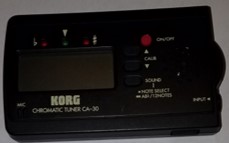 Now we get to the accoutrements! These are things I have added over time because they came in handy! They all either are essential to replacing a string, or just make it easier. Because remember – this is in my harp case, so I’m not at home, and I may be under time pressure to get the string changed before I have to perform! So I have:
Now we get to the accoutrements! These are things I have added over time because they came in handy! They all either are essential to replacing a string, or just make it easier. Because remember – this is in my harp case, so I’m not at home, and I may be under time pressure to get the string changed before I have to perform! So I have:
- String ends. String ends are used in a harp knot to give it a little more structure against pulling through the sound board. I have two types of string ends. The first are the traditional ones – bits of an old string cut into 1 inch pieces. These work and if you don’t have any, you can make some from a thicker nylon (or gut) string (preferably one that has broken) or you can buy them from reputable string sellers (some string vendors will send them gratis if you buy a lot of strings). But I also have a leather shoelace – the kind sold for boat shoes. They can be cut to the same one inch length as the bits of old string. The benefits of the shoelace are that they are a little easier to hold onto while tying the knot and they are soft and flexible which means that you don’t get buzzing which sometimes happens with the harder string ends. I keep the whole lace, but it would be more space efficient to make some cuts and keep them in the box.
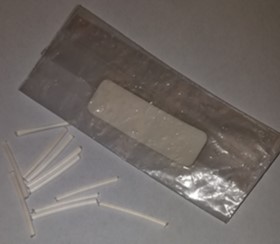
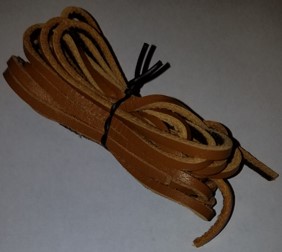
- Candle Sticky Stuff. I got this tip a long time ago. Putting just a little bit of candle adhesive onto the knot after you tie it makes it so much easier to seat the knot and get on with winding the string. This small tin holds wax. Just work up a small ball (like a pearl) – just enough to give you just enough tackiness to hold the knot together while you feed it through the soundboard (especially on the very thin strings at the top). It does save you a great deal of frustration and swearing! You can find this online or in hardware and craft stores and there are multiple brands available.
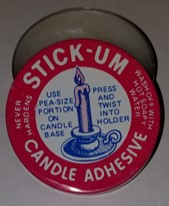
- Major nail care. I don’t know about you, but there’s something about having a gig that seems to make my fingernails grow! They can be fine when I leave but when I get ready to play, they have magically gotten too long! So I have this little cheap nail kit – I wouldn’t want to use it for day-to-day nail maintenance, but in a pinch, I can be sure that I feel confident that I’ve gotten my nails short enough. Bonus – I use the nail clippers to cut the string after I’ve gotten it wound on. I got this at a drugstore or a large square footage discount department store.
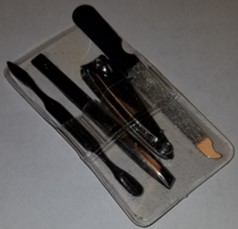
- Minor nail care. I found this little “matchbook” set of nail files and they have been in this box ever since. I prefer emery boards over metal nail files but have also used them to smooth chapped fingers as well. I got this at a drugstore or a large square footage discount department store. A single emory board would also work, but I thought these were cute.
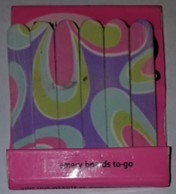
Thanks for taking a tour of the box! I hope it helps you plan something similar for your harp case. Do you have a similar box? What do you have in yours? What’s really worked for you? Let me know in the comments!

i have new cigarette filters-provided by harp circle ago. instead of a stiff , slippery plastic ,skinny stick, the soft fiber holds and is thicker = easier to work with.
i like the leather lace idea. candle wax/glue. hmmm
included in supplies are a small powder and lotion= for Me, not Her. those are in another pocket, tho.
Great topic, Jen. My first big harp from Melody Music came with a zippered 10” x 10” pouch. When I retired, Doug encouraged me to do something with my old ties. So I watched some YouTube tutorials and made some pouches-one for each harp. I think, in part, I was inspired by the beautiful drawstring pouch Susan Wilzer gave me years ago at OSAS (I still have it!).
Your lists are great since they are focusing on essentials without being all-encompassing. I’d add a small spare tuning key (or even the Dusty Strings tuner that has the attached Snark like Donna Bennet has), string chart, and baby powder. It’s weird, but sometimes my fingers squeak on the strings (especially gut). The baby powder does the trick, and can help with sweaty hands too.
Steve sent some great photos of some his solutions – check these out!
Hi Jen,
I like your box and its contents. Do you have another box for spare strings and do you have to carry a complete set? Thanks.
-Eby
I do – I keep a complete set of strings in my case pocket! In my favorite harp’s case they are in the plastic zip bag the string set came in – organized by order and bound with rubber bands so that if I have a broken string just before the bride comes down, I can easily find the right string and get it put on – no fuss, muss or bother. In my other harp’s case they are in an old CD wallet – again organized by order. We made these string holders as a craft project at (what is now) Harp Quest a few years ago.
Thanks, Jen! I may re-think my set-up. My current kit also has 2 new batteries for the tuner. And my business cards.
The candle adhesive and leather shoe string are new to me so I will see about adding them. I also don’t use the sandwich box – I have a velvet drawstring bag. But I still have the original cardboard tuner boxes, so they don’t get turned on by accident.
I keep the string knot pieces with the spare set of strings in a zippered plastic bag. The Candle stick-um and leather shoelace could go in with the spare strings too. The wheels are turning!
I like to keep a few vitamin E capsules, to soothe sore fingers. Cut it open, apply to skin, it works pretty well. Do not apply right before playing.
I also have a little (1″) packet of Sugru moldable glue. If your tuner or mic cords have exposed wires or are ready to break, cover them for an inch with this stuff. It’s flexible and durable. http://www.sugru.com.
A sharpie marker. To make lists, to color faded strings.
What great additions! Good thing there’s a little more room in my box!